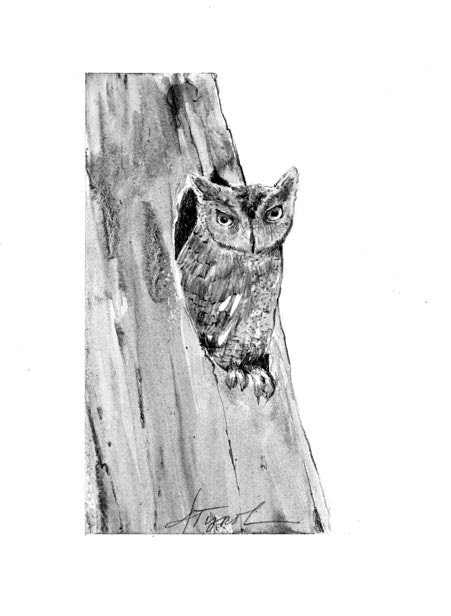
Many years ago I developed the habit of locating a stout walking stick whenever bushwhacking through the woods.The stick’s primary purpose isn’t for balance or support, it’s for whacking the occasional tree.When I encounter a tree with a cavity larger than about three inches in diameter, I often check to see that there are no dead branches above my head and then give the tree a couple of good raps with the stick, keeping an eye on the cavity entrance.Most of the time nothing happens, but once in a while I’m rewarded with a glimpse of the cavity’s occupant.I’ve had red squirrels, flying squirrels, screech owls, and even a weasel peer out, presumably to see what the racket was. In larger hollows, I’ve flushed roosting barred owls.
Tree cavities provide essential habitat for a variety of wildlife, from birds and mammals to insects, reptiles, and even amphibians.There’s good reason for this, of course. Cavities provide excellent protection from harsh weather and temperature extremes, they are relatively safe from predators, and they can be used for multiple years with little or no maintenance.As you might imagine, competition among the dozens of species that use tree cavities can be quite fierce, with more aggressive species often evicting the smaller or more timid ones, while occasionally two species will share a single cavity.
Aside from the day-to-day drama of eviction notices and cohabitation, cavity users fall into one of two basic groups: builders or squatters.Most of the builders, known as primary cavity nesters, are woodpeckers,while chickadees, titmice, and nuthatches can only excavate cavities in wood that has been softened by decay.The squatters, on the other hand (also called secondary cavity users), include a variety of other birds, small- to medium-size mammals, some snakes, tree frogs, and insects, all of which depend on cavities but are incapable of excavating them.Primary cavity nesters provide a critical function for secondary cavity users.Moreover, studies have shown that there is a significant relationship between the abundance of primary and secondary cavity-nesting birds, such that declines in the former lead to declines in the latter.
In Vermont and New Hampshire, we may be seeing an example of this relationship among three cavity nesting birds associated with open woodlands, forest edges, old fields, and agricultural areas.The American kestrel, eastern screech owl, and northern flicker are all showing long-term population declines.While there may be many factors contributing to this, several studies indicate that the flicker is the primary cavity excavator for both kestrel and screech owl, so that a decline in flickers could limit nest site availability for the two birds of prey.
Kathy Martin, a professor of forest ecology at the University of British Columbia in Canada, has been studying the ecology of cavity-nesting communities for many years.Along with her graduate students, Dr. Martin has found that both the northern flicker and pileated woodpecker are keystone species in forest communities – species that have a much greater impact on their community or ecosystem than would be expected based on their relative abundance.In the case of these two woodpeckers, it’s because they provide critical nesting and roosting habitat for such a wide range of species.Although there are nine woodpecker species that excavate cavities in British Columbia forests, most of the 32 species of secondary cavity users utilize holes made by northern flickers.And while pileated woodpeckers are much less abundant than flickers, they add to the cavity-nesting community by creating large, durable cavities that provide breeding and roosting sites for cavity-nesting ducks, raptors, and many mammals.In fact, both Barrow’s and common goldeneye ducks only use cavities excavated by pileated woodpeckers or those that occurred naturally.
Martin’s studies also revealed that excavators prefer quaking aspen over all other trees because of its susceptibility to heartwood rot, which provides a soft interior that is easily excavated, while the outer sapwood remains solid.In fact, within her study sites, aspen is considered to be a keystone species as well, because without it the cavity-dwelling community could fall apart.This has major implications for forest management in British Columbia.
In the Northeast, where forest communities have a greater diversity of tree species that share the cavity-friendly characteristics of aspen, including basswood and red maple, there is less reliance on a single tree species to provide the majority of cavities.So the next time you’re out for a walk in the woods, consider grabbing a walking stick and knocking on a few “doors.”You never know who might be home.

